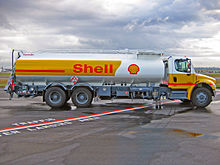Tank truck: Difference between revisions
m +id |
Ben9201996 (talk | contribs) No edit summary |
||
| Line 2: | Line 2: | ||
[[Image:Puerto Natales 2.JPG|thumb|[[Pegaso]] [[4x4]] tank truck at a [[Puerto Natales]], [[Chile]], [[gas station]]]] |
[[Image:Puerto Natales 2.JPG|thumb|[[Pegaso]] [[4x4]] tank truck at a [[Puerto Natales]], [[Chile]], [[gas station]]]] |
||
{{Unreferenced|date=April 2008}} |
{{Unreferenced|date=April 2008}} |
||
A '''tank truck''' ([[United States]] usage) or '''tanker lorry''' ([[United Kingdom]] usage) is a [[motor vehicle]] designed to carry [[Liquids|liquefied loads]], [[bulk cargo|dry bulk]] cargo or [[gas]]es on roads. The largest such vehicles are similar to [[railroad]] [[tank car]]s which are also designed to carry liquefied loads. Many variants exist due to the wide variety of liquids that can be transported. Tank trucks tend to be large; they may be [[Thermal insulation|insulated]] or non-insulated; [[pressurized]] or non-pressurized; and designed for single or multiple loads (often by means of internal divisions in their tank). Some are [[semi-trailer truck]]s. |
A '''tank truck''' ([[United States]] usage) or '''tanker lorry''' ([[United Kingdom]] usage) is a [[motor vehicle]] designed to carry [[Liquids|liquefied loads]], [[bulk cargo|dry bulk]] cargo or [[gas]]es on roads. The largest such vehicles are similar to [[railroad]] [[tank car]]s which are also designed to carry liquefied loads. Many variants exist due to the wide variety of liquids that can be transported. Tank trucks tend to be large; they may be [[Thermal insulation|insulated]] or non-insulated; [[pressurized]] or non-pressurized; and designed for single or multiple loads (often by means of internal divisions in their tank). Some are [[semi-trailer truck]]s. Tankers are very dangerous in that an explosion occurs when they crash. Many tank truck drivers die in the explosion. |
||
==Size and volume== |
==Size and volume== |
||
Revision as of 01:01, 26 May 2008


A tank truck (United States usage) or tanker lorry (United Kingdom usage) is a motor vehicle designed to carry liquefied loads, dry bulk cargo or gases on roads. The largest such vehicles are similar to railroad tank cars which are also designed to carry liquefied loads. Many variants exist due to the wide variety of liquids that can be transported. Tank trucks tend to be large; they may be insulated or non-insulated; pressurized or non-pressurized; and designed for single or multiple loads (often by means of internal divisions in their tank). Some are semi-trailer trucks. Tankers are very dangerous in that an explosion occurs when they crash. Many tank truck drivers die in the explosion.
Size and volume
Tank trucks are referenced by their size or volume capacity. Large trucks typically have capacities ranging from 4000 gallons (15,000 litres) to 9000 gallons (34,000 litres).
A tank truck is distinguished by its shape, usually a cylindrical tank upon the vehicle lying horizontally. Some other less visible distinctions amongst tank trucks are their intended use: compliance with human food regulations, refrigeration capability, acid resistance, pressurization capability, and others.
Common large tank trucks
Large tank trucks are used for example to transport gasoline to filling stations. They also transport a wide variety of liquid goods such as concrete, milk, diesel and industrial chemicals.
Common small tank trucks
Smaller tank trucks, with a capacity of less than 3,000 US gal (11,000 litres) are typically used to deal with light liquid cargo within a local community. A common example is a septic service truck (also known as a bowser) used to vacuum clean several septic tanks and then deliver the septic material to a collection site. These tank trucks typically have a maximum capacity of 3,000 gallons (11,000 litres). They are equipped with a pumping system to serve their particular need.
Another common use is to deliver fuel such as Liquified Petroleum Gas (LPG) to households. These trucks usually carry about 1,000 gal (3,800 litres) of LPG under pressure.
In popular culture
- In the 1986 series Transformers, a character named Octane had the ability to transform into robot, airplane and tanker truck modes.
- Tanker trucks have been used in several James Bond films during action scenes, in License to Kill (1989) and most notably in Casino Royale 2006 where a tanker with a terrorist driver is driven wildly around Miami Airport airfield.
- Two propane tankers were exploded to destroy a flock of zombies in Cell by Stephen King.
- A tank truck driven by Mel Gibson's character plays a central role in the climactic chase scene in the film The Road Warrior.
- In the film Convoy, Rubber Duck is hauling a tank of nitro-mannite, which makes the police move a road block to avoid explosion.
- For extreme fire scenes in action films tank trucks are often included, often as the victim of bad driving, ensuring that info is not leaked or that the enemy is dead, in both cases the fire guarantees this.
- In the film Duel, "David Mann" is chased by an unseen man in a tanker truck.
- In the film North by Northwest, the airplane that chases Cary Grant through a field crashes into the side of a gasoline tank truck.
- In the film Lethal Weapon 4, Mel Gibson's character shoots the valve on a criminal's backpack flamethrower, releasing the pressurized gas and launching the armored criminal into a nearby tanker truck, blowing it up.
